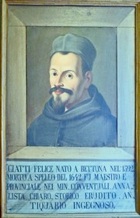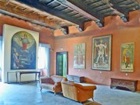

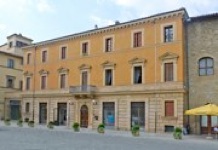
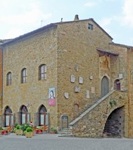
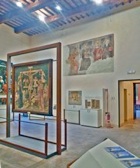
28 works of art were “stolen to order” from the gallery in 1987 and taken to Jamaica. They were recovered in 1990 and rehung in their original places. The renovated gallery re-opened in 1966.
Maestà with saints (1380)
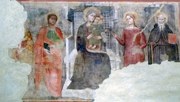
Assumption of the Virgin (early 15th century)
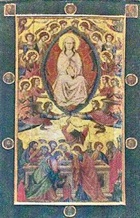
Crucified Christ (ca. 1470)
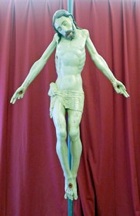
The figure has been associated with four panels of angels with instruments of the Passion, which came from a tabernacle in San Francesco al Prato and are now kept in the deposit of the Galleria Nazionale, Perugia. If this is correct, then all of these components came from a tabernacle that was financed by a bequest of 1470. This was designed to commemorate Angelo del Toscano, who had been the Minister General of the Franciscans from 1450 until his death in 1453. The sculpture has been attributed to Agostino di Duccio, who lived in Perugia in the period 1473-81.
Gonfalon (15th century)
This double-sided processional banner was documented in 1863, when it was in the house of the archpriest of Santa Maria Maggiore. It was the subject of litigation between the archpriest Morbidello and the Commune in 1902, but eventually passed to the latter. It was restored in 1927-8.
The banner is attributed to the workshop of Nicolò di Liberatore, l' Alunno. It depicts:
-
✴the Crucifixion with the Virgin and St John the Evangelist on one side; and
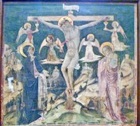
-
✴the Pietà with the Virgin and St John the Evangelist on the other.
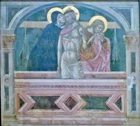
St Michael (15th century)
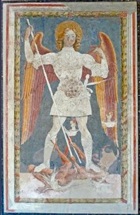
Altarpieces from Sant’ Antonio da Padova (ca. 1512)
These two altarpieces from the Convento di Sant’ Antonio da Padova were moved to Santa Caterina when Sant’ Antonio da Padova was suppressed.
-
✴The altarpiece depicting St Antony of Padua is signed by Perugino. The inscription also records that it was commissioned by Bartolomeo di Maraglia, who was taken prisoner by the French at the the Battle of Marignano in 1512 (when in the pay of Gian Paolo Baglioni). Bartolomeo di Maraglia is depicted in armour kneeling at the feet of the saint giving thanks for his release.
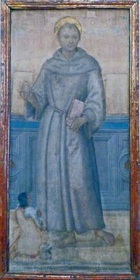
-
✴This altarpiece of the Madonna della Misericordia with saints is attributed to Perugino. It depicts the Madonna della Misericordia sheltering SS Stephen and Jerome and two kneeling donors (presumably a married couple).
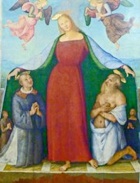
Gonfalone di Sant’ Anna (15th century)
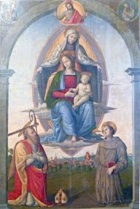
-
✴St Crispoltus on the left; and
-
✴Blessed Peter Negles on the right.
Trinity and St Roch (ca. 1503)
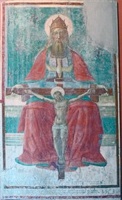

These two frescoes, which are attributed to Tiberio d’ Assisi, were detached from the ruined church of San Simeone, Tor d’ Andrea (on the borders with Assisi) in the early 20th century.
-
✴In the Trinity, the seated God the Father holds a Crucifix, with the Holy Spirit in the form of a dove above it. A now-lost inscription of the date “1503” was recorded on it in the 19th century.
-
✴In the other fresco, the standing St Roch is dressed as a pilgrim and displays the scars from the plague on his thigh.
Adoration of the Shepherds (1543)
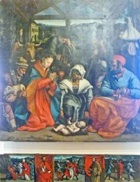
-
✴The main panel depicts the Virgin, an elderly nurse and St Joseph together with three shepherds, kneeling in a semi-circle behind the baby Jesus, who lies on the floor of the stable in which He was born.
-
✴The predella contains scenes from the life and martyrdom of St Crispoltus.
Virgin in Glory with Saints (1547)
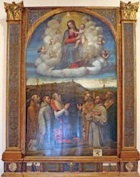
The main panel depicts the Madonna and Child in a mandorla of clouds and putti, with six kneeling figures below: SS Crispoltus; Francis; Jerome; (?); Antony of Padua; and Louis of Toulouse.

St Antony of Padua (16th century)
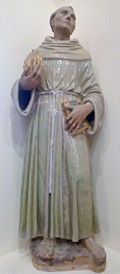
Immaculate Virgin with Saints (17th century)
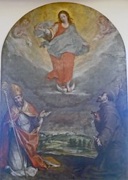
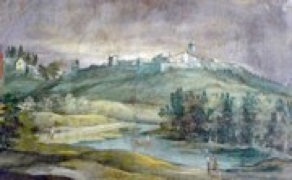
This altarpiece was documented in the Cappella del Santissimo Sacramento of the Chiesa di San Crispolto in the 18th century. It depicts the immaculate Virgin with SS Crispoltus and Francis. It has been attributed to Cesare Maggeri, a close follower of Federico Barocci. The lower part of the scene is set against a lovely townscape of Bettona, in which the San Crispolto is on the right the Convento di Sant’ Antonio da Padova is outside the walls, on the left.
St Peter (17th century)
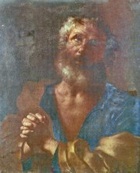
Paintings (17th century) from the Biancalana Collection
These include:
-
✴St Sebastian tended by Irene (1689), a study for the altarpiece in the Duomo, Città delle Pieve that is signed by Giacinto Boccanera and dated by inscription; and
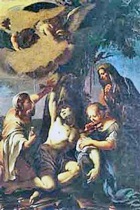
-
✴the Madonna and Child with SS Mary Magdalene and Barbara, which is attributed to Benedetto Bandiera.
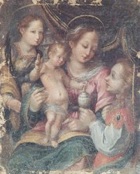
Portraits (19th century)
Two half-length portraits in the gallery, which depict Malatesta IV Baglioni and Felice Ciatti, probably belonged to a series of images of famous citizens commissioned for the Palazzo del Podestà.
-
✴Malatesta IV Baglioni, Count of Bettona was a famous mercenary soldier until he betrayed the city of Florence in 1530 (when the Emperor Charles V re-installed the Medici there). He retired to Bettona and died in Palazzo Baglioni in 1531.
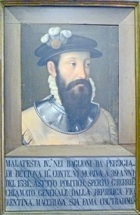
-
✴Felice Ciatti, who was born in Bettona in 1592, became Provincial Minister of the Franciscans. He was an eminent historian and one of the first to study the Etruscans, He died at Spello in 1642.
